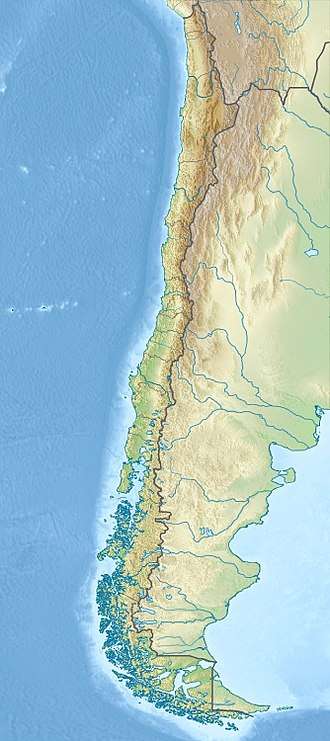Cerro Chajnantor Atacama Telescope
 Concept image of proposed Cerro Chajnantor Atacama Telescope (CCAT) | |
| Location(s) |
Purico complex, Chile |
|---|---|
| Coordinates |
22°59′09″S 67°44′25″W / 22.98592°S 67.74028°WCoordinates: 22°59′09″S 67°44′25″W / 22.98592°S 67.74028°W |
| Altitude |
5,612 m (18,412 ft) |
| First light |
2021 |
| Telescope style |
Radio telescope |
| Diameter |
6 m (19 ft 8 in) |
| Website |
www |
 Location of Cerro Chajnantor Atacama Telescope | |
The Cerro Chajnantor Atacama Telescope (CCAT) is a proposed 25 metres (82 ft) telescope that is intended to reveal the cosmic origins of stars, planets, and galaxies with its submillimeter cameras and spectrometers enabled by the superconducting detector arrays.[1][2]
Site
The planned site is at an altitude of 5,612 metres (18,412 ft), on Cerro Chajnantor of the volcanic Purico Complex, in the Atacama Desert of northern Chile. CCAT would be one of the highest permanent, ground-based telescopes in the world.[3]
Description
Submillimeter is a type of microwave radiation that is closest to infrared in the light spectrum. The telescope is to be outfitted with a wide-field camera that is expected to map the sky 1000 times faster and with better resolution than the SCUBA-2 camera installed on the James Clerk Maxwell Telescope in Hawaii.[4]
Construction
The CCAT consortium participating in the project includes: Cornell University; Associated Universities, Inc., University of Colorado at Boulder, University of Cologne, University of Bonn, University of British Columbia, and other universities in the U.S. and Canada. [5] [4]
Construction is projected to begin in 2015. The telescope is intended to complement the Atacama Large Millimeter Array (ALMA), by discovering new sources that ALMA will follow up with highly detailed imagery.[6]
In January 2014 the Chilean government granted the use of land on Cerro Chajnantor to the CCAT consortium for the telescope and the road to the mountain summit. [7] Also in January 2014, the Atacama Astronomy Park was inaugurated by the Chilean government, to coordinate activities between the current and upcoming observatories in the Chajnantor region. [8]
References
- ↑ National Research Council Report Highly Recommends CCAT CCAT News 12 November 2010
- ↑ Jonas Zmuidzinas bio NASA Accessed 28 March 2011
- ↑ The Cornell Caltech Atacama Telescope (CCAT); University of Cologne; Accessed 28 March 2011.
- 1 2 Renata D'Aliesio Astronomers hope telescope unlocks secrets of universe The Globe and Mail 28 March 2011
- ↑ CCAT : Partners . accessed 11.11.2014
- ↑ Lauren Gold $11M gift for Atacama telescope will help astronomers answer fundamental questions about galaxy, star formation Cornell Chronicle 12 November 2010
- ↑ Cornell Chronicle: "Chilean government grants land for giant telescope"; 16 January 2014.
- ↑ ccatobservatory.org; "Atacama Astronomy Park inaugurated"; 9 January 2014.